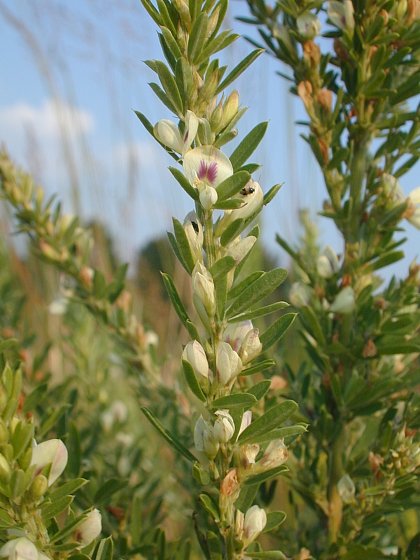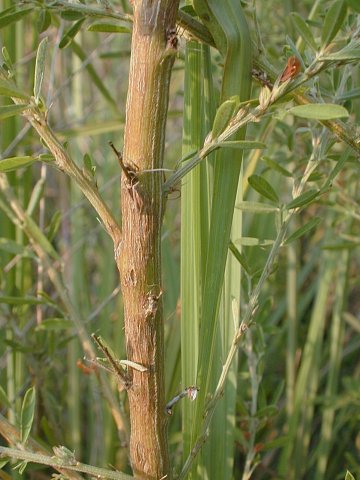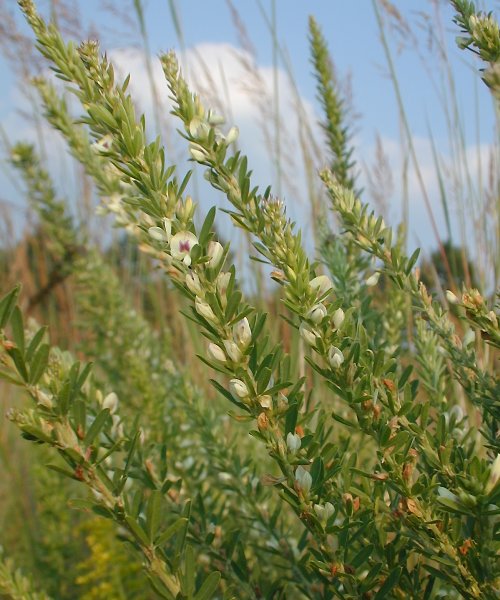Description: This perennial wildflower is 2-4' tall. It branches frequently into multiple major stems at the base, which divide into much smaller side stems. These stems are held stiff and straight at about a 45° angle from the ground or from each other. The entire plant has a shrub-like appearance that is vase-shaped at the base. It is herbaceous, notwithstanding appearances to the contrary, as all the stems die down to the ground each winter. Each stem is light green, round but strongly ridged, and covered with lines of appressed or slightly spreading white hairs. The lower stems become brown and woody with maturity, and they lose most of their hairs. The alternate compound leaves are trifoliate with short petioles. The leaflets are up to ¾" long and ¼" across. They are oblong or oblanceolate, and have smooth margins. The upper surface of each leaflet is dull green and hairless, while the lower surface is covered with silky appressed hairs. The blade of each leaflet often angles upward along the central vein, and it often has a fine point at its tip.

From 1-4 flowers
develop from the axils of the compound leaves on short stalks. Each
flower is about 1/3" (8 mm.) long, and has a typical pea-like structure
consisting of a broad standard and narrow keel. The petals are white or
cream, usually with a patch of purple at the base of the standard. The
pubescent calyx has 5 long teeth that often turn purplish green. The
blooming period usually occurs during early fall and lasts about a
month. There is no noticeable floral scent. Each flower can produce a
short pubescent seedpod containing a single seed. The root system
consists of a stout taproot. This wildflower spreads by reseeding
itself and
can form large colonies.
Cultivation:
This plant is usually found in full sunlight at sites that are mesic to
dry. It grows quite well in a slightly heavy clay-loam soil, and it is
not bothered much by foliar disease. Mature plants are quite drought
tolerant.

Range &
Habitat: The
non-native Silky
Bush Clover occurs occasionally in the southern half of Illinois, but
it is rare or absent elsewhere within the state (see Distribution
Map). However, this plant may be spreading steadily
northward. It was introduced into the United States from east Asia.
Habitats include fields, where it is occasionally planted as a source
of forage and hay, and roadside banks, where it has been planted for
erosion control. Other habitats include openings in upland woodlands,
thickets, and prairie restorations. This species can invade many
natural habitats and form dense colonies of plants. It is sometimes
introduced into prairie restorations accidentally, probably as a
contaminant of seed, and should be removed. The invasive potential of
this species is quite high.
Faunal Associations: The
flowers attract bumblebees and other long-tongued bees. The dagger bee,
Calliopsis andreniformis, is a common visitor of
the flowers of Lespedeza spp. The caterpillars of
the skippers Thorybes pylades (Northern Cloudywing)
and Thorybes bathyllus (Southern Cloudywing) feed
on foliage of Lespedeza spp., as do the
caterpillars of the moths Automeris io (Io Moth)
and Utetheisa bella (Bella Moth). The seeds are
eaten by some upland gamebirds, including the Bobwhite Quail and Wild
Turkey, while the palatable foliage is eaten by White-tailed Deer and
livestock.

Photographic
Location:
An upland area of a restored prairie at Meadowbrook Park in Urbana,
Illinois, where this species was accidentally introduced.
Comments:
Silky Bush Clover has a distinctive shrubby appearance with a V-shaped
base. From a distance, the narrow leaflets resemble needles on the
stems of an evergreen species. Its flowers are very similar in
appearance to those of Lespedeza capitata
(Round-Headed Bush Clover), but the latter species branches much less
and its leaflets are longer and broader in size. Another common name
for Lespedeza cuneata is Chinese Bush Clover.